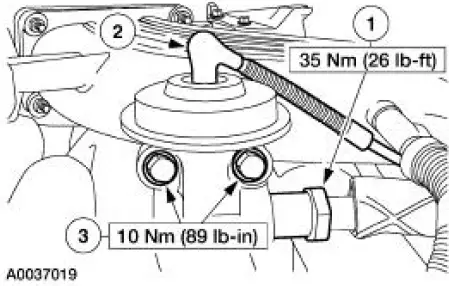Ford Mustang (1999-2004) Service Manual: Exhaust Gas Recirculation (EGR) Valve - Mach I
Removal and Installation
1. Remove the air intake scoop. For additional information, refer to Section.
2. Remove the exhaust gas recirculation (EGR) valve.
1. Disconnect the EGR tube upper fitting.
2. Disconnect the vacuum hose.
3. Remove the two bolts and remove the EGR valve and gasket.

3. CAUTION: Do not use metal scrapers, wire brushes, power abrasive disks or other abrasive means to clean the sealing surfaces. These tools cause scratches and gouges, which make leak paths. Use a plastic scraping tool to remove all traces of old sealant.
Clean and inspect the mating surfaces.
4. To install, reverse the removal procedure.
- Install a new gasket.
 Exhaust Gas Recirculation (EGR) Valve - Cobra
Exhaust Gas Recirculation (EGR) Valve - Cobra
Removal and Installation
1. Disconnect the accelerator cable and the speed control cable.
2. Remove the accelerator cable bracket bolts.
3. Release the clip and position the accelerator cable bra ...
 Exhaust Manifold to Exhaust Gas Recirculation (EGR)
Valve Tube
Exhaust Manifold to Exhaust Gas Recirculation (EGR)
Valve Tube
Removal and Installation
NOTE: 3.8L shown, 4.6L (2V) similar.
1. With the vehicle in NEUTRAL, position it on a hoist.
2. Disconnect the exhaust gas recirculation (EGR) valve tube from the
exhaus ...
Other materials:
Air Bag Supplemental Restraint System (SRS) (Diagnosis and Testing)
Refer to Wiring Diagrams Cell 46 , Air Bag for schematic and connector
information.
Special Tool(s)
Diagnostic Tool, Restraint
System
418-F088 (105-R0012)
Restraint System Diagnostic Tool Warning
WARNING: This tool is for restraint system se ...
Spark Plugs
Special Tool(s)
Remover, Spark Plug Wire
303-106 (T74P-6666A)
Material
Item
Specification
Silicone Brake Caliper Grease
and Dielectric Compound
D7AZ-19A331-A or equivalent
ESE-M1C171-
A
Removal and Installation
CAUTION: ...
Power seats
WARNING: Never adjust the driver’s seat or seat back when the
vehicle is moving.
WARNING: Before returning the seat back to its original
position, make sure that cargo or any objects are not trapped
behind the seat back.
The power seat control is located
on ...
